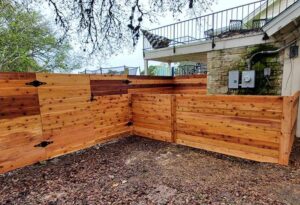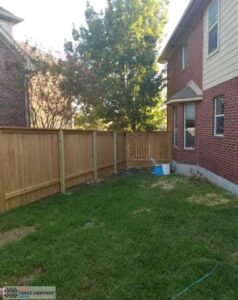Color Without Heat: Finish Choices That Don’t Cook Your Yard
TL;DR
You can have a rich, modern fence color in Austin without turning your patio into a skillet. The trick is balancing pigment (UV defense), light reflectance (LRV), and surface build so the fence absorbs less heat, glares less at eye level, and weathers gracefully. Favor penetrating, mid-tone stains with transparent iron-oxide pigments, avoid heavy films, and combine color choices with shade, airflow, and layout tweaks. Need a stain color/finish plan that matches your exposure and HOA rules? The local pros at Atlas Fence Company will spec a finish that looks great and feels cooler on west- and south-facing runs.
Table of Contents
ToggleWhy Austin Fences Feel Hot (and What Color Has to Do With It)

Austin summers combine intense UV with high surface temperatures. A dark, film-forming coating on a west-facing fence can push board temperatures well beyond 120°F at 3 p.m. Heat doesn’t just make the fence unpleasant to touch—it radiates into the patio, warms nearby masonry, and bakes landscaping. Color is a significant lever: lighter tones reflect more energy, while ultra-dark tones drink in solar gain. But “go very light” isn’t the complete answer—too pale fades faster and can glare. The right path is mid-tone, UV-stable color in a penetrating system that runs cooler and weathers evenly.
When we plan color/finish for clients from Circle C to Lakeway, we also consider outdoor spaces, starting with your yard’s sun path and going from comfort first, aesthetics second. The team at Atlas Fence Company can measure exposure and build a color that suits both style and climate.
Heat, Shade, and Sightlines: What “Comfort” Really Means
“Cooler” isn’t only what a thermometer says. Comfort around a fence is a mix of:
- Surface temperature (touch safety for kids and pets).
- Radiant load (how much the fence radiates back toward seating).
- Glare management (can you face the fence at 5 p.m. without squinting?).
- Acoustic softness (a hotter, harder film can “drum” more in the wind).
- Visual depth (colors that hide dust and sprinkler tracks look “cooler,” too).
We design for all five, so your yard feels usable even during an August evening cookout.
The Physics (Light, LRV, Emissivity) in Plain English
You don’t need a PhD—just the gist:
- LRV (Light Reflectance Value): 0 = black, 100 = pure white. Mid-tones (LRV ~30–50) reflect enough light to control heat without looking chalky.
- Pigment type: Transparent iron-oxide (TIO) pigments block UV while letting visible light through, giving natural wood read without “painted” heat.
- Emissivity: Surfaces that emit heat well will cool faster at dusk. Many penetrating stains leave the wood surface breathable, helping heat shed more readily than thick films.
- Gloss: Higher gloss reflects light as glare (hot to your eyes); low-sheen reads softer and “cooler.”
Finish Families: Which Ones Run Coolest Here
Penetrating, Non-Film Stains (Best for Heat + UV)
- Why they run cooler: Minimal surface build = lower radiant “skin.”
- Why they last here: They erode gracefully instead of peeling, especially on south/west exposures.
- Color behavior: TIO mid-tones keep color truer and cooler.
- Great for: Cedar privacy fences, especially board-on-board or dense horizontal.
If you’re leaning this way and want a pro application tuned to Central Texas exposures, our fence staining services in Austin can dial the chemistry and the cadence so the color stays true without cooking your hardscape.
Hybrid Oil-in-Water Emulsions (Good if Truly Penetrating)
Cleaner application, but make sure the product explicitly states it is non-film-forming and shows TIO/UV stabilizers on its tech sheet.
Film-Forming Acrylics/Polyurethanes (Use Sparingly)
- Pros: Wide color range, uniform look.
- Cons in Austin: Heat build, potential glare, higher chance of peel on west faces, and they radiate heat back toward the patio. If you must have a near-paint look, confine it to north- or east-facing areas or shaded courtyards.
Color Strategy by Exposure (North, East, South, West)

- South-Facing Runs: Brutal UV at midday. Choose mid-tone natural browns; avoid near-black. Keep sheen low.
- West-Facing Runs: Peak heat late day. Consider one step lighter than your first instinct and add shade (trees or a trellis) near seating.
- East-Facing Runs: Morning sun is gentler; you can go slightly darker or richer here without a heat penalty.
- North-Facing Runs: Minimal UV—dark accents are safer if you want contrast, but they may read cooler (visually) than they feel since temps stay down.
We often split palettes by elevation so the yard reads cohesive while each run performs optimally.
Palettes That Work: Warm Neutrals, Desert Reds, Modern Browns
You want color without the heat penalty. These families hit the sweet spot across Austin neighborhoods:
Warm Neutrals (Bee Cave & Lakeway vibes)
- Tones: Honey, mesquite, light chestnut.
- Why they feel cool: Mid-LRV, excellent UV masking, minimal glare.
- Pair with: Limestone or pale stucco homes, drought-tolerant planting.
Desert Reds (South Austin bungalows)
- Tones: Light redwood, toasted terra-cotta.
- Why they work: TIO reds resist fade, radiate less heat than espresso, and still read “rich.”
- Watch for: Match the house’s roof undertone so it doesn’t shout.
Modern Browns (Tarrytown & Zilker moderns)
- Tones: Saddle, walnut-lite, cocoa.
- Why they work: Deeper color without dropping LRV too far.
- Execution: Keep it matte/low-sheen to kill glare.
For inspiration with real backyards and tones that photograph well in Texas light, see our style roundup on fence color ideas for Austin—it’s packed with palettes that stay attractive without spiking temps.
Glare Control: Pretty Without the Eye-Squint
Even a semi transparent finish mid-tone can “look hot” if it glares at 5 p.m.
- Keep sheen low. Penetrating stains are naturally low-luster.
- Add cap & trim. A crisp, slightly lighter cap line diffuses light and frames color.
- Break up long runs. Subtle post wraps or shadow lines prevent mirror-like stretches.
- Mind the hardscape. Light pavers reflect; placing darker planting beds in front of them lowers perceived glare on the fence.
Layout & Material Tweaks That Drop Temperatures
Color choice is half the battle; design finishes it.
- Air gap + greenery: A slim planting strip in front of the fence (native evergreen clusters) shades the lower third and cools reflected heat off patios.
- Board-on-board density: Blocks sun flecks that superheat specific boards and age color unevenly.
- Steel posts with cedar wraps: Keeps lines straight so low-sheen colors look smooth (wobbles = bright/dark bands).
- Horizontal with discipline: Shorter spans and dual-screw patterns prevent “smiles” that catch the sun and appear lighter/hotter.
- Light-tone accents near seating: Even a 16–24″ mow strip or light seating wall in front of a mid-tone fence narrows the radiant window to people’s height.
- Shade structures: A modest pergola wing or trellis on the west side cools the experience more than a single shade tree (and avoids root issues at the property line).
If your plan includes new lines, gates, or a change to a horizontal style, we can bake these cooling moves into the structure from day one. Our fence installation team in Austin lays out posts, panels, and caps so the color you choose performs as comfortably as it looks.
Austin Constraints: HOA, Greenbelt Views, and Pools
- HOA height & color rules: Many HOAs restrict extremes—blacks and ultra-lights. We stay inside the palette while tuning LRV and sheen for comfort.
- Greenbelt adjacency: Expect more dust and late-day sun. We lean toward mid-tones that hide grit, keep temps down, and preserve privacy.
- Pools: Chlorinated splash + hard water leave mineral rings that glare on dark films. Penetrating mid-tones hide this better and are easier to refresh without sanding.
- Corner lots: Sight triangles sometimes force lower sections—use lighter accents and planting for cooling where height can’t help.
Application Windows and Maintenance That Keep Colors True

Color longevity isn’t just about the can; it’s about when and how you apply.
- Surface temp control: Stain in the mornings or in shaded late-day conditions, keeping boards under ~95°F to prevent flash.
- Back-brush every board: Evens pigment and prevents hot-spot streaking that reads “blotchy hot.”
- Clean → brighten → dry: Prep opens grain so pigments seat deeply, which stabilizes color through heat cycles.
- Refresh cadence: On west/south runs, plan a light wash and refresh at 24–36 months. North/east can stretch to 36–48 months.
- Sprinkler discipline: Minerals make any color look harsher. Adjust heads or add shields near fence bays.
For hands-off upkeep that keeps your yard comfortable and your color consistent, our fence staining services in Austin can lock in a maintenance rhythm tied to exposure and tree canopy.
Sample Specs for Real Austin Lots
Barton Hills, West-Facing Patio
- Goal: Rich color, low evening heat in the dining zone.
- Spec: Penetrating alkyd with TIO pigments in light chestnut (LRV ~40), matte. Board-on-board for density; cap & trim one step lighter for glare control.
- Add-ons: 24″ limestone mow strip and a narrow evergreen hedge. Result: Noticeably cooler at 6 p.m., no squint.
Steiner Ranch, Greenbelt Edge
- Goal: Maintain privacy, hide dust, avoid “oven wall.”
- Spec: Penetrating stain in saddle mid-tone (LRV mid-30s), matte. Steel posts with cedar wraps; horizontal slats with short spans.
- Add-ons: Trellis wing on the west bay; irrigation shields. Result: Color stays rich, dust is less visible, and comfort is improved.
Circle C, Mixed Exposures
- Goal: Cohesive look around a pool without glare.
- Spec: Honey-to-mesquite palette (LRV 45–50) on south/west runs; one shade deeper on north/east. Penetrating, back-brushed.
- Add-ons: Light cap line; darker planting bed in front of light pavers. Result: Balanced color, no “flash” at waterline.
FAQs
You can use very dark accents on north- or east-facing runs or in deep shade. For west- and south-facing areas, we recommend mid-tones or a two-tone approach (dark only where the heat is gentler).
Not automatically. Ultra-light clears can fade faster. Mid-tones with TIO pigments typically hold both color and comfort best here.
Often warmer in full sun because of density and pigment. If you want composite accents, keep them shaded or off west-facing spans.
The higher sheen glares and can feel visually hotter. Low-sheen reads calmer and hides dust and mineral tracks better.
We’ll work with the sheen, density, cap color, planting, and layout so the yard still feels cool.
Get a Cooler-Feeling Backyard (Free Walkthrough)
Ready to pick the best fence stain colors that looks amazing and keeps your patio usable at 5 p.m.? We’ll map your sun, pick a mid-tone that resists Austin UV, spec a finish that runs cool, and make layout tweaks that drop radiant load. Call (512) 366-8108 or start here to lock your slot: request a fence and gate estimate.
